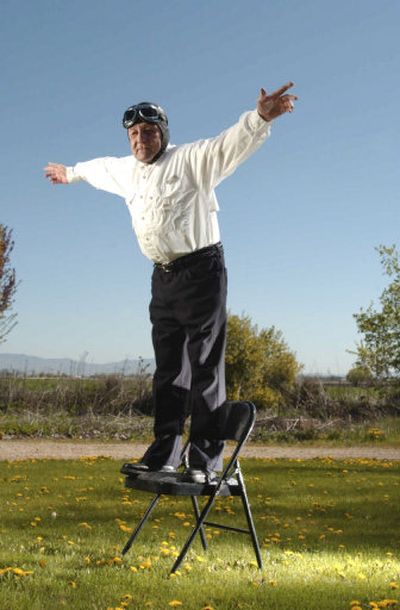High flier on solid ground in Kuna

KUNA, Idaho – When Johnny Kazian’s son was a little boy, he thought his father was Batman.
“It wasn’t surprising,” Kazian said. “How many dads wear a leather helmet and goggles to work?”
These days, Kazian and his wife live quietly in a rural area near Kuna in southwestern Idaho. The only clue to his remarkable career is found on his license plates: Stunt 1.
Kazian made his living as a Hollywood stuntman for nearly 35 years. He also was a wing walker, credited with saving the death-defying practice from virtual extinction.
An Idaho resident for 32 years, Kazian grew up in Philadelphia. It was there that his high-flying lifestyle began, with a casual inquiry and a trapeze.
“My father was an Armenian immigrant who designed rugs,” he said. “He had a friend who was in the circus. His friend didn’t have a son of his own, and one day when I was 7 he asked my father if he could train me. I don’t know any 7-year-old who wouldn’t want to be a trapeze artist.”
He did his first professional show, at Coney Island, N.Y., in 1947. He was 14. Kazian spent two seasons flying hand-to-wrist with the Ringling Brothers Circus. When the Korean War began, his skills made him a natural candidate for aviation training. He became a Navy pilot and was flying a seaplane when his wrist was badly broken in a crash. The break didn’t heal properly, ending any chance of returning to his job as a trapeze artist.
What initially looked like bad luck, however, proved to be a jackpot
“A friend helped me get a job as a stuntman in Hollywood. You do a little of everything when you work in a circus. I’d been a tumbler, as well as a trapeze artist, so I knew how to fall and hit an air bag.”
He worked as a stuntman in movies and television programs, doubling for James Brolin, David Hasselhoff and other actors. But it was wing walking that brought him his greatest fame. The practice of walking on wings of airplanes while they do loops and rolls was popular during the barnstorming era of the 1920s. With the more powerful planes that followed, higher speeds made it increasingly difficult and dangerous. By the time Kazian began experimenting with it in the late 1950s, wing walking had become a memory.
“He’s the one who reinvented it,” said Illinois aerobatic pilot Dave Dacy, who worked with Kazian for 10 years. “Johnny found a way to bring it back at the higher speeds.”
It took him two years to perfect the techniques. “I learned that if you make yourself an airfoil at the higher speeds, you’ll be lifted off the wing,” Kazian explained. “The key is to lean forward at the correct angle into the wind.”
Kazian retired from stunt work in 1994.
“I found out then that my wife was worried the whole time and never let on,” he said. “She was afraid of the phone call telling her I’d fallen.”